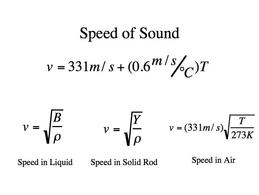
Review the fact that sound is a mechanical wave and requires a medium through which it is transmitted. Just as a transverse wave alternates between peaks and troughs, a longitudinal wave alternates between compression and rarefaction. From this figure, you can see that the compression of a longitudinal wave is analogous to the peak of a transverse wave, and the rarefaction of a longitudinal wave is analogous to the trough of a transverse wave. Figure 14.4 shows a graph of gauge pressure versus distance from the vibrating string. But some of the energy is also absorbed by objects, such as the eardrum in Figure 14.5, and some of the energy is converted to thermal energy in the air.

The amplitude of a sound wave decreases with distance from its source, because the energy of the wave is spread over a larger and larger area. For ordinary, everyday sounds, pressures vary only slightly from average atmospheric pressure. Gauge pressure is the pressure relative to atmospheric pressure it is positive for pressures above atmospheric pressure, and negative for pressures below it. The graph shows gauge pressure (P gauge) versus distance x from the source.
SPEED OF SOUND FORMULA SERIES
You may recall from the chapter on waves that areas of compression and rarefaction in longitudinal waves (such as sound) are analogous to crests and troughs in transverse waves.įigure 14.4 After many vibrations, there is a series of compressions and rarefactions that have been transmitted from the string as a sound wave. Some of the energy is lost in the form of thermal energy transferred to the air. The pressure disturbance moves through the air as longitudinal waves with the same frequency as the string. regions are compressions, and the low pressure regions are rarefactions. This creates slightly higher and lower pressures. As the string oscillates back and forth, part of the string’s energy goes into compressing and expanding the surrounding air. Some sound waves can be characterized as periodic waves, which means that the atoms that make up the matter experience simple harmonic motion.Ī vibrating string produces a sound wave as illustrated in Figure 14.2, Figure 14.3, and Figure 14.4. A disturbance is anything that is moved from its state of equilibrium. More specifically, sound is defined to be a disturbance of matter that is transmitted from its source outward. Review properties of waves-amplitude, period, frequency, velocity and their inter-relations. Review waves and types of waves-mechanical and non-mechanical, transverse and longitudinal, pulse and periodic.
SPEED OF SOUND FORMULA MANUAL
In addition, the High School Physics Laboratory Manual addresses content in this section in the lab titled: Waves, as well as the following standards:

Liquid water is exceptional in this respect as (∂u/∂T) p they differ slightly and u p < u g < u s.The learning objectives in this section will help your students master the following standards: Since the speed of sound in liquids varies only slowly with pressure, u generally declines also with increasing temperature along an isobar. For normal saturated liquids, u declines steadily from its value at the triple point to zero at the liquid-gas critical point. The speed of sound in the pure saturated liquid is always greater than that in the coexisting vapor. įor the saturated vapor of a pure substance, u at first increases with temperature and, after passing through a maximum, it then declines to zero at the gas-liquid critical point. Some examples of u(T, p → 0) for gases at T = 300 K are: 4He, 1019 m/s CH 4, 451 m/s N 2, 352 m/s air 348 m/s and n-butane, 194 m/s. Is a slowly varying function of both T and p. All real gases approach this behavior at sufficiently low pressures, but generally u(T, p)/ Thus the speed of sound in a perfect gas is proportional toīut independent of pressure.


Where M is the molar mass and γ pg is the heat-capacity ratio for the perfect gas.


 0 kommentar(er)
0 kommentar(er)
